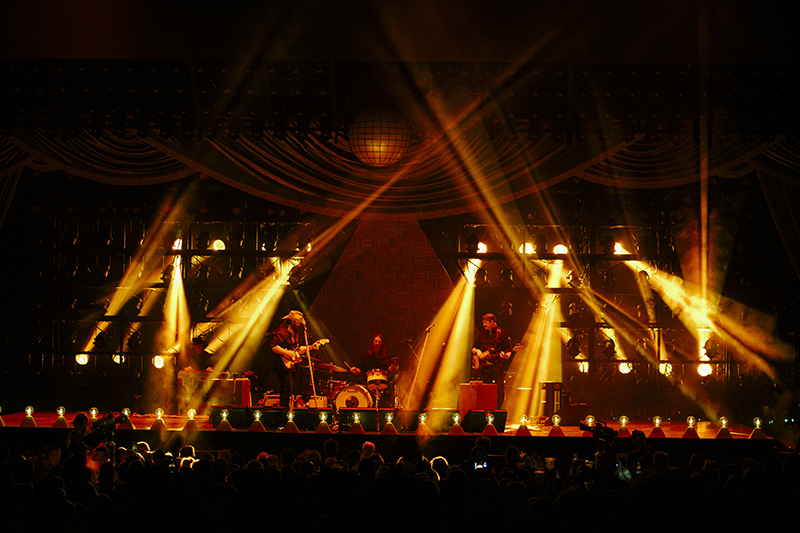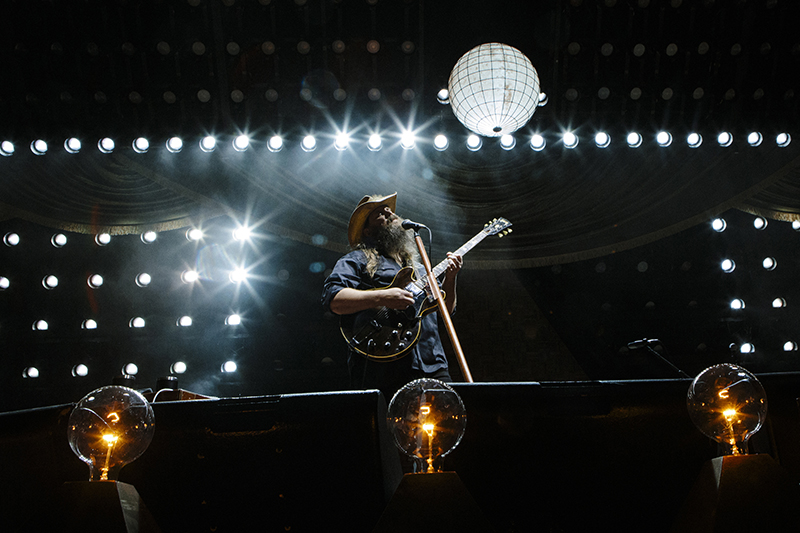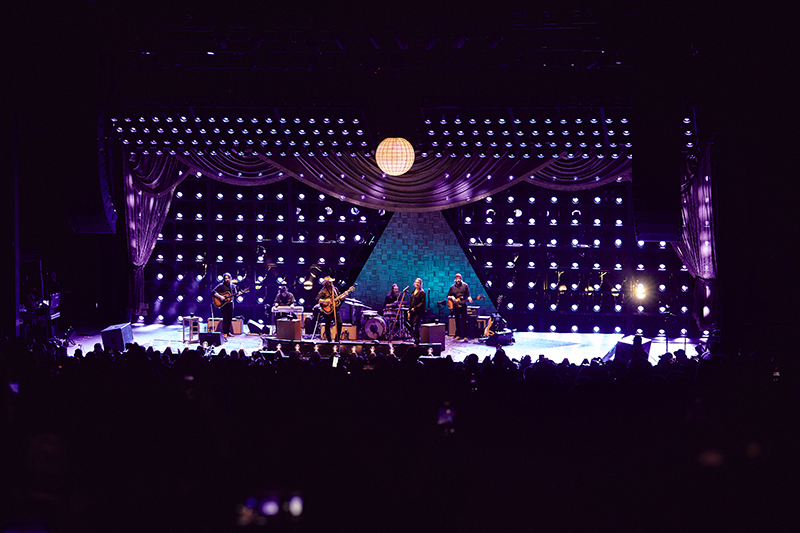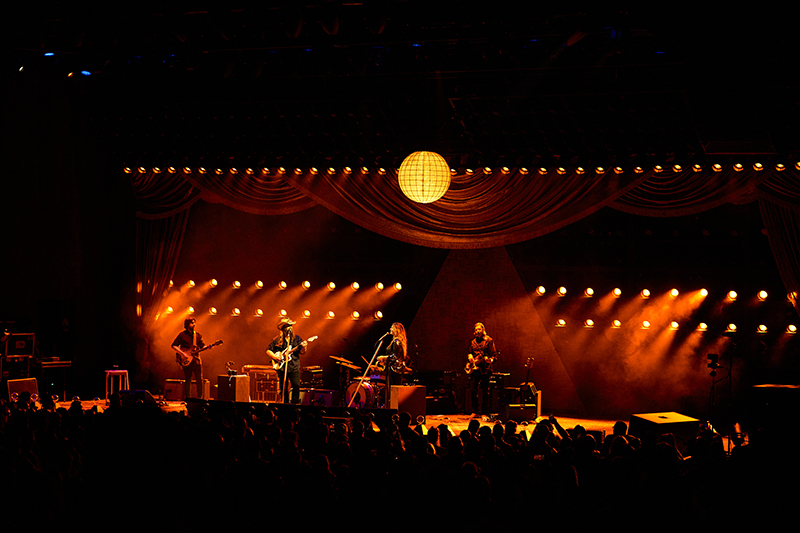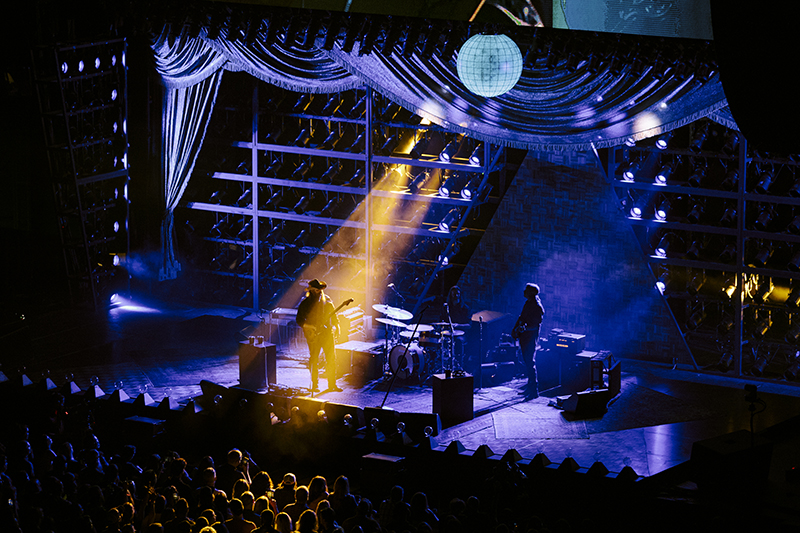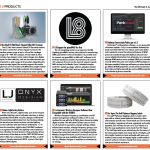
It takes the whole team to support the All-American Road Show
“It all started with a napkin sketch from the artist portraying an old school PAR can rig. From that piece of paper and Ron and Becky’s input, I put together the plot.” So says Lighting Designer Mac Mosier, who teamed up with Production Designer Bruce Rodgers, Creative Designer Becky Fluke, and Video Director Ron Etters to design Chris Stapleton’s 2021 All American Road Show tour.
“Working and designing with Chris Stapleton is always an interesting process because he is a very visual person who has strong opinions on style and materials that fit his brand,” says Rodgers. “But he’s also a sonic expert, having spent most of his career in recording studios and various types of venues. The fun challenge is to mix the visual design with smart acoustic design.”
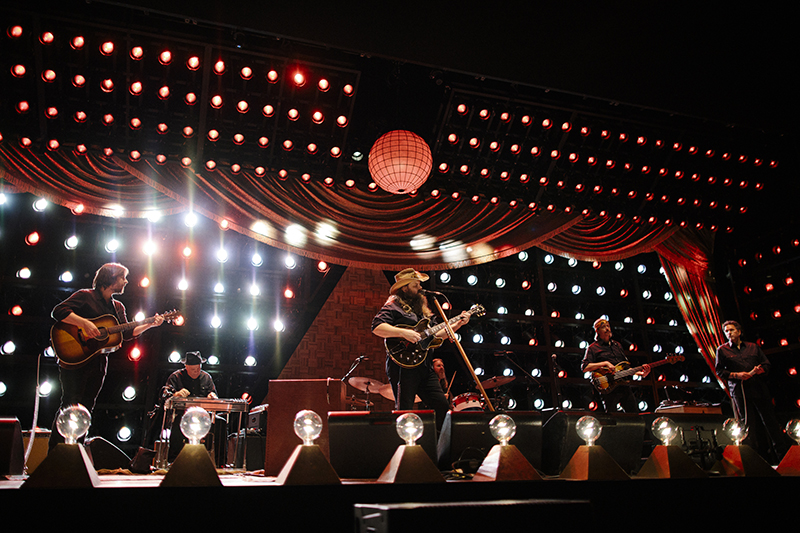
Rodgers designed Stapleton’s last tour, creating a touring band shell that was scientifically designed to react like a recording studio. “This new design has similar details but includes a great amount of light in the sculpture of it,” he explains. “It’s a great thing when you have an artist and production team that supports a unique tour design, and the audience reactions are a good indication that we’re doing a good job.”
Mosier has been lighting bands for some 40 years including looking after Stapleton’s live shows since 2018. “We programmed just prior to March 2020 when Covid shut us down,” he comments. “It was a bummer to polish up this project only to sit on it for about 18 months, waiting for the tour to get the green light.”
Fluke, who has been with the artist since 2013, confers with Mosier and Etters on the show’s visuals. “We did one show in Corpus Christi—then pulled the plug. Eighteen months later we regrouped,” explains Fluke. “It was a unique perspective. Mac and I started looking at looks we’d come up with and questioning ourselves. ‘Why did we choose this look?’ Some changes were made, but the basics were in place.” Etters, the video director for the past year, adds, “This whole tour is a collaborative effort between Becky, Mac, and the entire video team. Everyone out here had some input into the final production.”
The rig looks massive, as 400-plus Vari-Lite VL800 EventPARs built into truss pods, make up the bulk of the system. The pods are divided into a rear wall, a couple of side panels and an additional overhead wall. Completing the look is a rectangle of video that runs across the top of the lighting structure. “There are times when Ron used the robocams to capture part of the stage such as some PARs on full, then uses that content on the video wall to simulate even more PARs, essentially giving us a complete floor to ceiling look of PARs,” says Mosier. “I’ll agree, it makes quite a statement when they’re all on.”
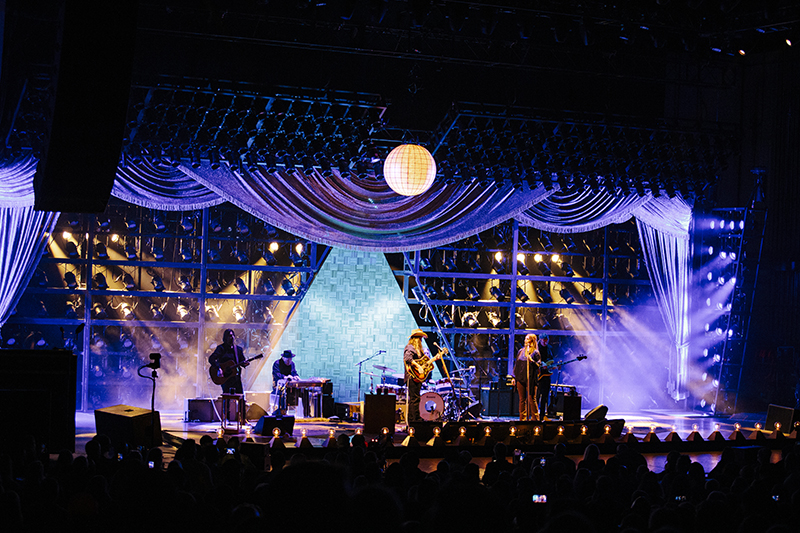
The rear wall of PARs is separated in the center by a wooden triangle set piece. This, along with an LED lit globe (dubbed the Orb) hung over the stage were all ideas of the artist. “The idea with the wood set piece is we have something else we can light with colors to make a look. Tye Trussell at Gallagher Staging fabricated the lighting pods so the wooden sections making up the triangle are actually built into the design,” Mosier explains. “With the wood taking light exceptionally well, it fits into the design perfectly.”
“We lift the whole wall up six feet to accommodate set changes,” says Trussell. “Chris’ band and band gear live on a rolling riser from Gallagher that’s 40’W x 20’D and made up of an inlaid rose wood and oak parquet flooring.” The band consists of Chris and his wife Morgane Stapleton downstage center, with only a single guitar, pedal steel, bass, and drums joining them on stage.
As for Gallagher Staging’s relationship with this camp, Trussell explains, “From the very beginning when Chris and Morgane walked into our shop looking for some set pieces to enhance their performance before his first album dropped—till this moment—the whole team has been a pleasure to work with. We have built some great things together and have even gotten a patent along the way.”
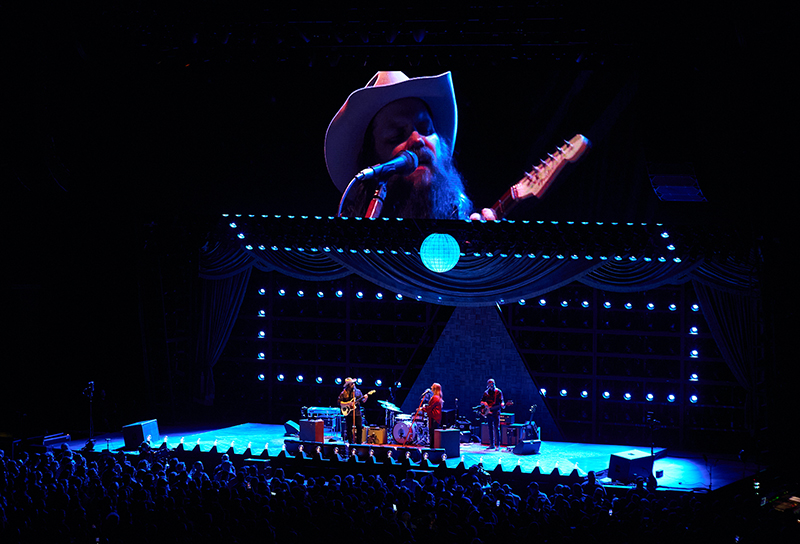
Changes in Lighting
“I haven’t had a lot of PARs in a rig in quite some time,” claims Mosier. “So cloning the show from the last tour to this one took a lot of thinking. We try not to turn all the PARs on at once. Instead, we create motion through these static lights chasing.” While the PARs are prevalent in the design, Mosier incorporated other movers into the lighting rig. “Chris had requested the video elements play high above the band and not behind it. I decided to blow light from the VL 3500s right through our wall of PARs.”
“For key lights I looked at what Premier Global had in stock and chose the Ayrton Ghibli as my preferred source; 24 of them pick up the band members with a hard edge that cuts through the wall of light from the pods. To light the wooden triangle, I use Chroma-Q Color Force 48s from the floor. Additional lights from the side pods illuminate the face of the lighting pods as well.”
Once the artist had spelled out what he was looking for, it was up to the team to source the tools. Mosier explains, “I was impressed with the ADJ LED PAR 64s as they had that physical look we were striving for. But then we got our hands on the Vari-Lite model and they seemed to be twice as bright. The selling point was [that] the EventPAR fixtures all had RGBA color mixing and the ability to manually change the lenses.”
Lining the front of the stage are some tungsten footlights that act more like set practicals than illuminating the faces. “The Ghibli key lights from the rear are more overhead top light than rear fills. The front truss provides the key front light and hangs six-foot downstage of the stage. We have artists wearing cowboy hats that aren’t big on blinding footlights,” Mosier states.
Fluke adds, “Since Chis and Morgane face each other a lot when they sing, I persuaded them to allow us to place two ARRI SkyPanel fixtures on the floor, nested in between the Clair monitors. We keep them at low levels, and they do their job for our cameras, but don’t irritate the artists.” To light the audience Mosier placed 26 Elation CuePix WW4 blinders in the set. A row of them lines the front truss while others blast through the rear wall of PARs.
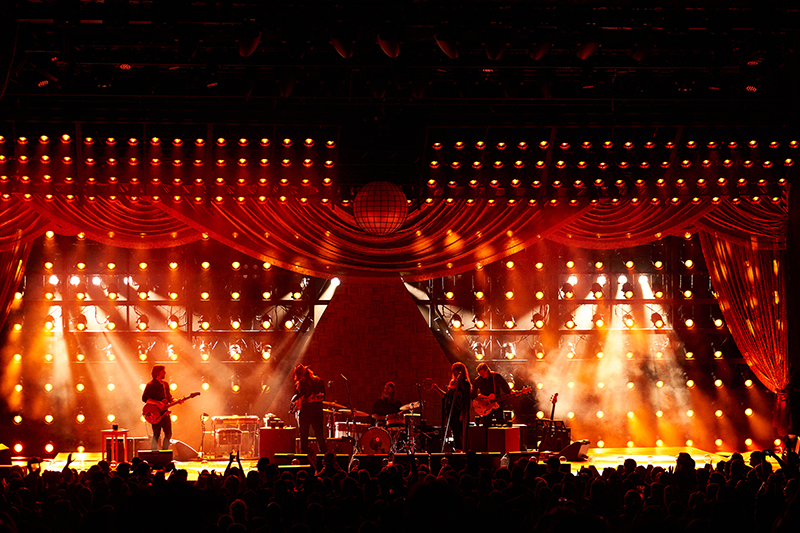
Finding the Fixtures
Kevin Blevins, general manager/business manager for Premier Global Production, is the account manager in charge of finding the fixtures. He ended up having to get the EventPARs from as far away as Europe and China. Blevins adds this about PGP’s relationship with this camp. “Mac has always been a treat to work with. Not only does he have a unique eye, but he also takes a strong interest in the mechanics of a touring lighting system, how it loads-in and loads-out each day, what will be best for the tour. It’s one of the reasons every PGP crew has loved working with him. A gentleman always, but also a smart creative person who wants the best for everyone involved.”
Blevins adds, “Mac’s design provides the perfect overall visual look for the music of Chris Stapleton. It is a beautiful production design, befitting of one of country music’s biggest arena superstars. The Stapleton relationship has been one of the best our company has ever had. It’s a fair, straight-shooting camp full of wonderful, courteous people. It starts with Chris and Morgane themselves and goes down to the touring techs in every department. You would be hard pressed to find better people to work with on a production of this size than day to day Manager, Clay Hunt, Production Manager, John Garriott; Tour Manager, Jason Hecht; and Tour Rigger, Matt Jumper. Great guys with a wealth of experience who just get it.”
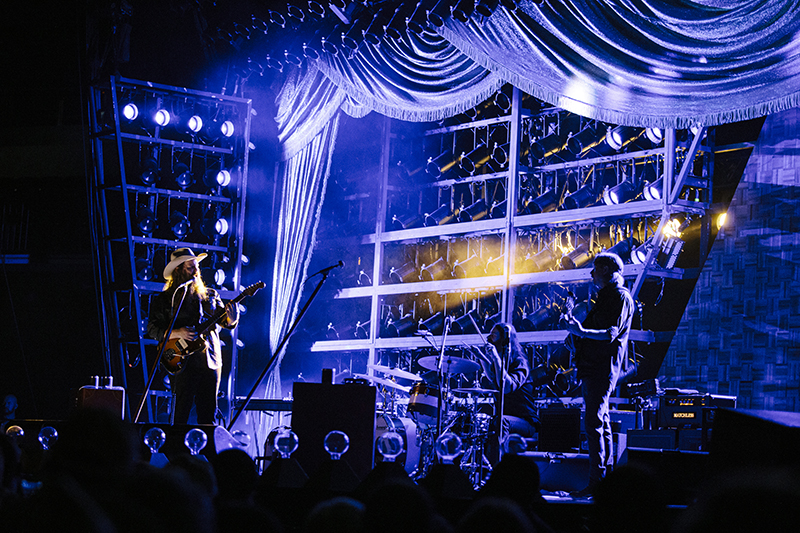
Video Scenes
“It was Chris’ idea to put the video above the lighting,” adds Mosier. “He did not want to have the wall behind the band as that would interfere with the classic old-school, retro look the artist was trying to achieve with all the PARs.” The 12’H x 56’W wall features 162 of Moo TV’s 8mm custom tiles and flew above the midstage (22’ from the downstage edge.)
According to Video Crew Chief Tyler Buell from Moo TV, “Ron and our Engineer John [Holeman] spent countless hours in rehearsals getting the looks and robo moves dialed in to perfection. They have been at the front of this design as well. They came up with many looks for the wall that we still use today. We all work toward a common goal to make the best show we can every day.”
From the start of the tour, Etters has been working hand in hand with Holeman, his system engineer, shader, and robocam operator. Says Etters, “From day one John and I really dove in to make the unique aspect ratio of the LED wall work for us. There’s times we cut the screen into multiple parts, at one point in the show all 12 cameras are on the screen at once.”
Adds Fluke, “What we liked was we had the ability to stretch a guitar neck across the whole width of the video wall or separate them into different sections. It was the goal to not make the whole show look like we had three separate video screens overhead all the time.”
Four Hitachi HD500 cameras are used from the front, two of which ride on a custom 10’ wide dolly camera track system that crew chief Buell along with the Moo TV shop team created. Four POV cameras and another four robocams are used for Etters to choose for live shots. Two of the robocams hang from the bottom of the video wall for overhead shots. The POV cameras are strategically placed around the stage. Etters says, “We have one on the steel guitar, another on the kick drum pedal. We have one we use for a reverse shot mounted upstage that gives us great audience participation looks at prominent times.”
Fluke claims, “It was Chris’ direction that he wanted the audience to see the players from different angles with shots they would never get to see from their seats. His idea was to separate the video from lights physically yet marry them together in each scene. We’ve done a good job at matching them and the color schemes.”
Etters uses a Ross Carbonite 2ME HD Switcher to cut the cameras, but also looks after the Dataton Watchout media server. “We don’t have any media, but we use the server to manage the composition of each scene. The media server also helps us manage this untraditional screen size.”
The video wall flew above the midstage (22’ from the downstage edge.) Additional side projection screens are used as well. When the local venue does not have them, Moo TV steps in with additional I-Mag screens for the side seats. Holeman enjoys the team’s attention to detail. “Ron does an incredible job each night at communicating with the camera operators to set up shots as well as calling the robocam cues to me. It’s tough, calling cameras for multiple positions at once while switching. I give huge props to Ron and his camera team for giving us plenty of material to play with.”
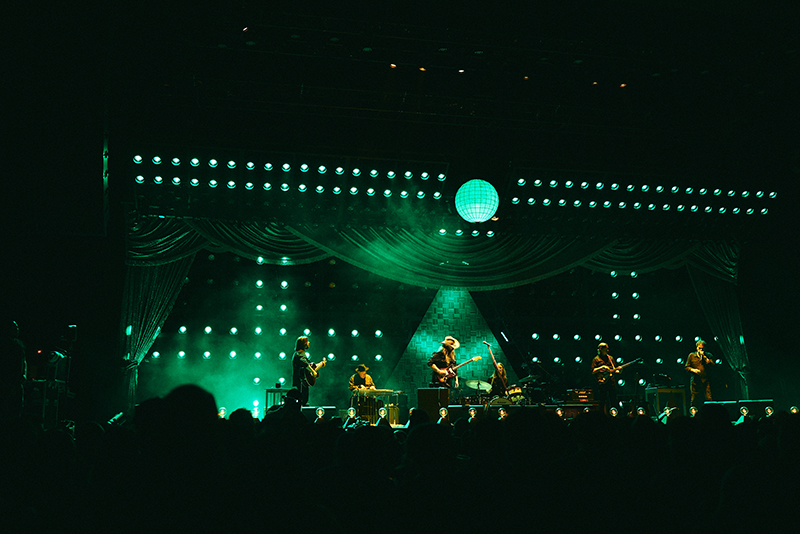
Putting the Pieces Together
Production Manager John Garriott, with Stapleton for six years, expands on the logistics. “We carry eight production trucks and an additional one for merch. OTL [On Tour Logistics] looks after our trucking needs. Occasionally we play multiple nights in the same town, but we tend to work the weekend circuit. Load-in at 8:00 a.m. when time allows, and we are ready for sound check six hours later. The crew is tight. In the beginning, this team was built on the premise that everyone had toured with someone else on the crew at one time or another. So, everyone’s ability was vouched for by someone else on the crew. That philosophy helped build the best team out there in touring today. Simply put—the CS touring crew is number one.”
Clay Hunt looks after the day-to-day operations. After 17 years on the road, he joined Red Light Management three years ago, and steers this ship from the shore. “With a tour this size, it takes a team to put it all together,” Hunt explains. “From the initial napkin sketch the artist showed me, we engaged the entire team—working through the costs, logistics, time of setup—there are so many factors involved. My specialty is, I can jump in and move all the pieces around until it all fits. It’s the job of all of us to look at the big picture, to make sure the artist’s vision comes to where it needs to be. We speak with everyone early in the design process. We ask, ‘How is this going to work once we get out on the road?’ It’s a fun process seeing it all come together.”
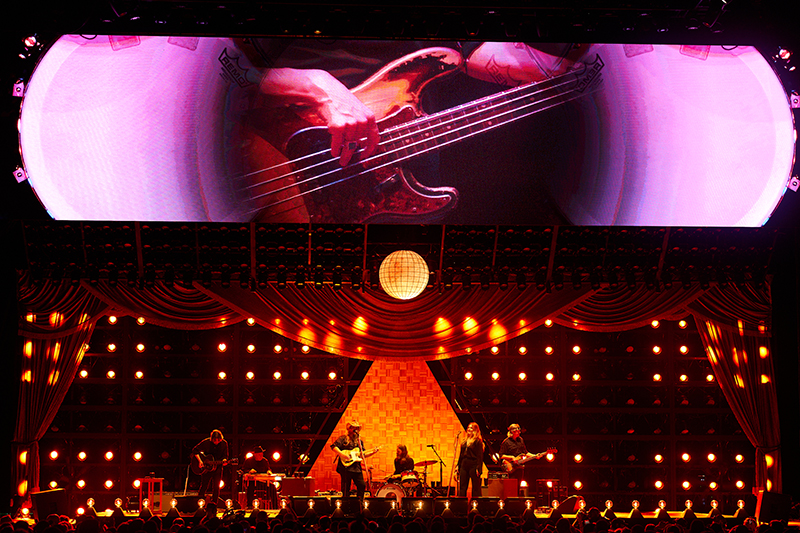
Hunt also gives kudos to Louisa Pierce and Emily Ward, a design duo that added their scenic touches to the final design. “These two ladies have worked with us before. We turned to Louisa and Emily for some input to capture the artist’s ideas. For instance, we know the artist mentioned a parquet floor, we needed a design, and they came up with the inlay work and end look.” While the stage is big, it’s designed with soft goods to look more intimate. Separating the rear wall of lights from the overhead structures is a grand curtain supplied by Atomic. Hunt says, “The ladies came up with this idea. They also came up with the ‘Orb,’ the circular sphere that Tye figured out how to illuminate. They chose the carpet on stage as well as the wood riser the band plays on. They worked in tandem with Rodgers’ team to put all these pieces together [who] then handled all the artistic renderings.”
He continues, “We achieved an amazing show with all of these elements. Chris is an analog soul in a digital world. We have an old school concept with the lighting but using new technology. It feels like a Queen show from ‘83, or Genesis in ‘86. All the ideas came from Chris, but the end results were achieved by the best team I’ve ever worked with.”
Fluke sums it up. “We’re big at having a balanced feel for cameras and lighting. We are also concerned with levels being perfect for fan photography.” In that respect Mosier adds, “Becky has her fingers in everything. She knows what every camera will look like with every color. She’s a master at looking at the whole scene as one big visual. Ron and John are irreplaceable; they have mastered the art of coming up with fresh looks for every song. With Clay at the helm, all opinions and ideas were considered. Indeed, it took a team of professionals to bring a show of this stature to life. Our team is proud of the end result of all this hard work.”
Chris Stapleton’s 2021 All American Road Show tour schedule wrapped up with two shows at Nashville’s Bridgestone Arena in December. The tour will resume this spring, with more dates set to extend into the summer.
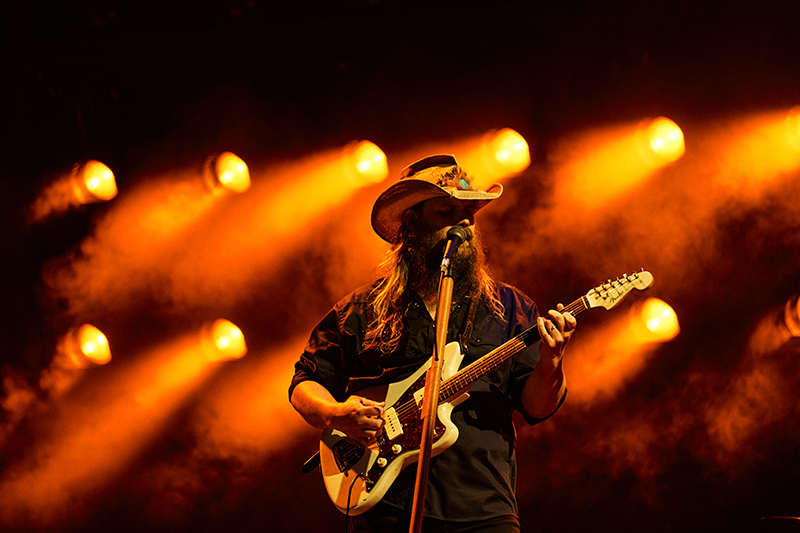
Chris Stapleton 2021 Tour
Vendors
- Lighting: Premier Global Production/Kevin Blevins
- Scenic: Gallagher Staging & Productions/Tye Trussell
- Video: Moo TV
- Soft Goods: Atomic
- Trucking: On Tour Logistics
Crew
- Artist Management: Red Light Management/Coran Capshaw, Zach Peters, Clay Hunt
- Creative Designer: Becky Fluke
- Lighting Designer/Director: Mac Mosier
- Video Director: Ron Etters
- Production Manager: John Garriott
- Tour Manager: Jason Hecht
- Lighting Crew Chief: John Nichols (PGP)
- Lighting Techs: Mark Donahue, Matt McBride, Slade Allen
- Rigging: Matt Jumper, Anthony McKale
- Video Engineer/Robotic Camera Operator: John Holeman
- Video Crew Chief/SR Pit Camera: Tyler Buell
- LED Tech/SL Pit Camera: Derek Bain
- Projectionist/FOH Camera: Jonathan Paine
- FOH Camera: Matt Jumper
- Production Personnel: Katie Wilkinson, Holly Atherton, Tanisha Mize, Todd Green
- Creative: Andy Barron, Roxi Barron
- Carpenters: James Ford, Shawn Lovell, Jonah Fickel
Gear
- Lighting
2 MA Lighting grandMA2 full-size - 400 Vari-Lite VL800 EventPAR RGBA
- 14 Vari-Lite VL800 EventPAR WW
- 20 Vari-Lite VL3500 FX
- 24 Ayrton Ghibli
- 22 Martin MAC Aura
- 8 Martin MAC Axiom
- 26 Elation CuePix Blinder WW4
- 6 Chroma-Q Color Force 48
- 2 Applied Electronics Two-Universe Opto Splitter
- 1 TMB ProPlex sACN/Art-Net Box (16-Universe)
- 4 hazebase Base Hazer
- 44 1-Ton Motors
- 2 ¼-Ton Motors
Video
Camera Package:
- 4 Hitachi HD500 Camera
- 4 Marshall CV365-CGB POV Camera
- 4 Panasonic AW-HE130KP Robotic Camera
- 2 Custom Dolly Camera Track System
- 1 Dataton Watchout Server
- 1 Ross Video Carbonite 2ME HD Switcher
LED Package:
- 162 8mm Custom Moo TV LED Tiles
- 27 Tiles W × 6 Tiles H (56’ W x 12’ H)
Projection Package:
- 2 Barco HDX-W20 Projector
- 2 Eiki 15K LC-XT5 Projector
- 2 20’ × 11’ Projection Screen
More photos:
